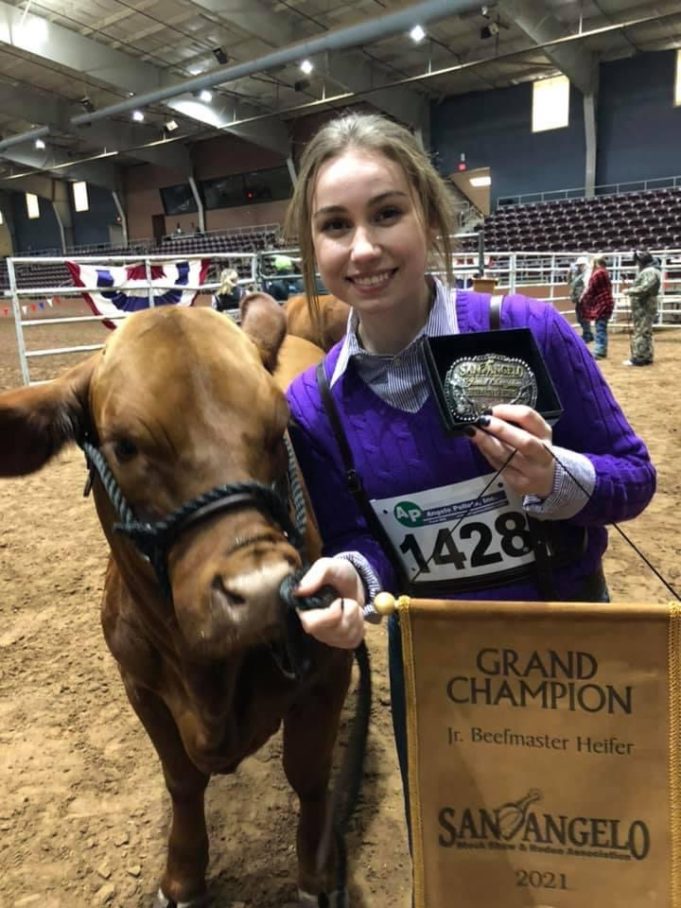In mid-February, as winter storm Uri sent Texas temperatures plummeting, Sarah Wells made the return trip from a junior livestock show in San Angelo to North Texas. The Grapevine High School (GHS) sophomore wasn’t returning simply to hunker down in her home and wait out the storm. Several cows, sheep, goats, and pigs at the high school’s barn, part of GHS’ Future Farmers of America (FFA) program, were in danger, and Wells and her peers began making regular trips to the unheated barn to break ice so the animals could access water.
Keaton Gilbreath, an 8th grader at Cross Timers Middle School in Grapevine, also tended to the health and welfare of the livestock. GHS agriculture science teacher Ashby Williams said the level of dedication expected from the teenagers in her program makes them a “different breed of student.”
The team effort paid off. Despite bitterly cold temperatures and the partial loss of running water, the students saved the lives of numerous livestock and provided comfort to the animals during a stressful ordeal.
“We had one heifer we had to give shots to,” Williams said. “She got pretty sick in the cold. For the most part, I was surprised how the cattle who weren’t used to the cold climate were able to adapt.”
Gilbreath, Wells, and several dozen students from the Grapevine-Colleyville school district are now preparing to compete in the Tarrant County Jr. Livestock Show at Will Rogers Memorial Center. The large event that runs Wednesday through Saturday is typically overshadowed by the Fort Worth Stock Show and Rodeo (FWSSR), which normally runs in January but was canceled due to COVID-19.
Brandi Gilbreath, Keaton’s mother, said the timing of the FWSSR has historically caused the junior show to “get forgotten.”
The media attention, she continued, “is slowly coming to our show. A lot of these kids show at the FWSSR and then prepare for the county show.”
Attendance, sponsorship, and media attention raise proceeds for the FFA program, she said, and those monies are then saved for college funds or to underwrite next year’s FFA projects.
In the minds of many, livestock shows primarily consist of cattle being paraded then judged for market quality, but the Tarrant County Jr. Livestock Show features a wide range of contests, Williams said. Keaton is exhibiting two market Angus steers and submitted several photographs he took of a stockyard in Oklahoma. Wells said she will be showing three breeding heifers and her brother’s market steer.
Both teenagers expressed interest in a career in agriculture or the livestock industry. GHS’ program offers a wide range of courses in the animal and plant sciences in addition to leadership classes. Seniors can even graduate with a vet assistant certification, Williams said.
“We have about 60 kids on our FFA roster,” Williams said. “If you put those numbers in comparison with football or sports as a whole, we are obviously pretty small. It’s funny how many kids were thrown into this field because it initially fit their class schedule. Then they become really involved and find an entirely different career path that they didn’t know existed.”
Sports and band garner much of the resources at North Texas public schools, but the work that FFA chapters undertake every day in schools here and across the country ensures that Americans will have a safe and stable food supply for years to come, Williams added.
The teenagers said the quality and personalities of the people who work in agriculture are a leading reason the students plan to pursue a career in the animal and plant sciences.
“I am very proud of Keaton and the others in our chapter,” Brandi said. “These kids work really hard and long hours. At stock shows, a lot of them are up and at the show barns as early as 4 a.m. preparing for the show. They spend long days in the cold or in the heat. That’s my favorite thing about being a show mom — seeing how dedicated and hard these kids work.”












